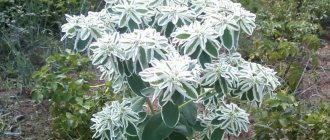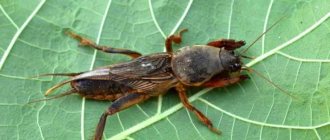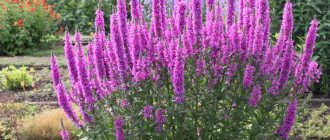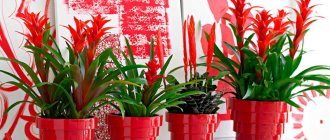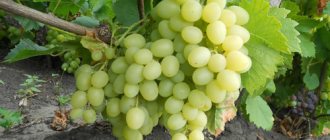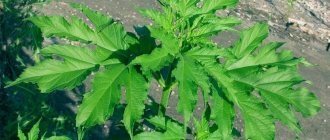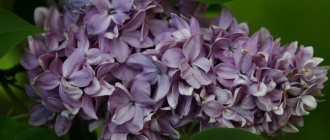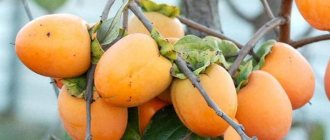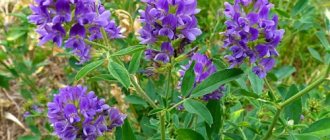Grass to die - beneficial properties and contraindications
Common gooseberry is one of the widespread forest plants. Belongs to the Umbrella family. This is a herbaceous plant characteristic of deciduous forests. It can be found even after cutting down oak forests.
Moleweed is a perennial that lives under the canopy of shady forests and has adapted to conditions of low light.
Throughout the summer, only the leaves of the basal rosette form in the forest. Flowering shoots appear only in autumn, when the leaves on the trees thin and the forest brightens.
It also blooms in summer on the edges and forest clearings; there is enough color here and there is little competition from light-loving plants.
Many gardeners are well acquainted with honeydew as a weed. This weed is extremely unpretentious, reproduces well and can also appear in garden beds.
Common gooseberry is an edible plant; previously its leaves were eaten fresh and fermented like cabbage. Now, of course, it is little used for food, but is used as a medicinal plant. And therefore, in this article we will talk about the beneficial properties of this plant.
Where can I meet and how to find out
Rot is so common that in Europe and Asia it can be found almost everywhere! You can find it among both deciduous and coniferous trees.
In thickets of bushes, in parks, forests, ravines, along roads, in gardens and vegetable gardens. Well-moistened soil with any composition is enough for her. It can grow both in the sun and in dense shade. Snitch is absolutely unpretentious.
For such unpretentiousness, omnipresence and the ability to spread its roots in all directions (including to a depth of up to a meter) along the ground, gardeners do not like it so much. To prevent the borer from crowding out all the cultivated plants on the site, they wage a constant struggle with it, often to no avail.
The borer is a bright representative of the Umbrella family. It can be recognized by its straight tubular stem (from 50 centimeters to a meter in length), trifoliate leaves, and small white flowers (collected in a characteristic “umbrella”).
Flowering can be observed in June-July, after which small brown berries appear in place of the flowers.
Growing dreamweed in the garden
How to sow seeds
The plant is sown like any other herb. Sowing is carried out in spring or before winter. The sown area must be limited so that the weed does not spread throughout the garden. To do this, iron sheets or slate are dug along the perimeter of the bed so that they go into the ground at least 30 cm.
- Conditions for growing hosta in a flowerbed
Creeping wheatgrass - harm and benefit, planting and care
If you want to grow decorative honeydew on your property, you can purchase its seedlings in specialized stores or garden pavilions. It is better to first plant them in plastic or iron containers with drainage holes, and then dig these containers into the soil in the flower garden.
In the photo: Flowering dream
The moth prefers shady places and grows well under trees, but in a sunny place the variegated variety of the plant will not be so attractive.
Caring for the dream
Water the trees regularly. During drought, the plant requires more frequent watering, but water consumption should be moderate. Decorative varieties and plant species require periodic sanitary pruning: diseased, dry and damaged shoots should be removed. Some gardeners renew their greenery by completely mowing down the plant.
Hogweed - how to fight, treat burns, beneficial properties
To preserve the decorative appearance of the plant, it is necessary to promptly remove the peduncles with inflorescences, otherwise the sapling will gradually degenerate into a wild-growing form: only the common sapling can grow from the seeds spilled on the ground.
When growing squash in poor soil, it is advisable to add fertilizers to the soil - organic or mineral - at the beginning of summer. However, do not overdo it: it can do without feeding.
In the photo: Dream leaves
The plant is winter-hardy and can withstand frosts down to -39 ˚C without requiring shelter.
- Pyracantha: growing and caring for the garden
Pests and diseases
Sometimes the tree is attacked by aphids or spider mites. This usually happens during a period of prolonged drought. If you notice that the leaves of a plant are curling, take a closer look at them and you will likely find pests parasitizing the plant. They destroy mites and aphids with solutions of Actellik, Matcha or Aktara.
Dwarf can suffer from fungal infections that cause anthracnose or powdery mildew. These diseases must be combated with the help of drugs Skor, Horus, Maxim, Radomil Gold or other fungicides of similar action.
Chemical composition
Our ancestors knew for a long time that borer has high nutritional properties. According to modern folk healers, its chemical composition is similar to the formula of human blood. They claim that this plant has a rich biological composition that is very beneficial for humans.
Among them:
- Polyacetylenes (natural pesticides with pronounced antifungal properties). Due to this, the leaves of the tree can be used to prevent food spoilage. These same substances are actively used in experimental medicine as an antitumor component.
- Amino acids that take part in redox processes.
- Essential oils with pronounced antiparasitic properties.
- Flavonoids, which have a beneficial effect on the urinary system, demonstrate anti-inflammatory and antiallergic properties.
- Carotene (vitamin A), which has an antioxidant effect, promotes skin regeneration and slows down the aging process.
- Coumarins (natural antibiotics with anti-inflammatory and analgesic properties). Take part in activating hair growth.
- Polypeptides that take an active part in carbohydrate metabolism.
- Saponins. Actively stimulate secretory function and intestinal motility.
- Steroids affecting cholesterol metabolism.
- Organic acids. They demonstrate antioxidant, choleretic, diuretic, anti-inflammatory and antitoxic properties, stimulating the immune system.
- Choline, which takes part in lipid metabolism and has a hepatoprotective effect.
- Phytoncides, which are excellent immune stimulants, have antibacterial, antiviral and antifungal properties.
- Complex of vitamins and microelements. This herb (especially young) is a source of many beneficial substances, thereby stimulating the immune system and strengthening the body.
Such a rich chemical composition of honeydew makes it indispensable in the practice of traditional medicine.
Sleeping in cosmetology
The herb is useful for women, helping to maintain youth and beauty. The rich chemical composition of honeydew allows it to be effectively used for cosmetic purposes. Skin care masks are prepared on its basis.
For oily skin - crushed fresh leaves of sedum in the amount of 2 tbsp. l. and chopped oatmeal - 1 tbsp. l. combine, add warm milk until mushy. Apply the mask to your face, leave for 20 minutes, rinse with warm water.
For dry skin - egg yolk and olive oil in the amount of 1 tsp. mix with 2 tbsp. l. crushed dream leaves. Apply to previously cleansed facial skin, leave for 15 minutes, rinse with warm water.
Rejuvenating mask – 2 tbsp. l. combine freshly squeezed juice with 2 tbsp. l. grated fresh cucumber and tsp. honey Spread the mixture on gauze and apply to the face, leave for 20 minutes.
It is good to rinse your hair after washing with the infusion of dandruff; the procedure will get rid of dandruff and make your hair healthier.
Warm baths with herbal infusion will have a rejuvenating and softening effect on the skin of your hands.
Variegated gooseberry is grown in garden plots as an ornamental plant
Medicinal properties
Alternative medicine considers honeydew to be an indispensable plant for general health, prevention and treatment of a number of diseases. It has the following effects on the body:
- Anti-inflammatory (fights inflammatory processes in the gastrointestinal tract, muscles, blood vessels, joints).
- Used for gastritis, arthritis, gout, neuralgia.
- Antitumor. According to naturopaths, the dream contains substances that can fight cancer cells, and therefore fight cancer (reduce metastases, slow down the growth of tumors, support after chemotherapy).
- Hepatoprotective. Activates the process of restoration of liver cells - hepatocytes, regulates lipid metabolism, improves metabolism.
- Antibacterial. Fights pathogenic microflora (viruses, bacteria, fungi). Shows bactericidal properties when used externally (nail fungus, bedsores, skin ulcers).
- Intoxicating. Blocks the production of free radicals, removes toxins and salt deposits.
- Choleretic. Helps to establish the processes of formation and excretion of bile, relieving spasm of the bile ducts. What is the prevention of cholecystitis and dyskinesia of the gallbladder.
- General strengthening. Due to the high content of vitamins and microelements, it takes part in redox processes and has a general strengthening and rejuvenating effect on the body. Can be used to strengthen the body after illnesses.
- Antihypoxic. Strengthens the walls of blood vessels, increases their tone, promoting normal blood flow.
- Antiscorbutic. Due to the high content of ascorbic acid, it has an antioxidant effect. It prevents colds, acute respiratory infections, and scurvy.
- Diuretic. Improves blood circulation, helps fight edema due to heart and kidney pathologies.
- Sedative. The essential oils contained in the plant have a calming effect. Can be used under high physical and emotional stress. Helps strengthen memory.
- Painkiller. Reduces inflammation, helps with pain in muscles and joints. Healing. Stimulates regenerative processes, especially in relation to the skin.
Also, it helps lower blood pressure, remove toxins from the body, and can be used as one of the components of a diet for weight loss.
Indications for use
Due to its rich chemical composition and complex of medicinal properties, representatives of alternative medicine recommend pine to help externally and internally with the following diseases and conditions:
- tumors;
- atherosclerosis;
- avitaminosis, scurvy;
- renal pathologies;
- gastrointestinal diseases;
- gallbladder pathologies;
- gout, arthritis, arthrosis, rheumatism, myositis;
- decreased hemoglobin;
- problems with the nervous system;
- neuroses, insomnia;
- diseases of the cardiovascular system;
- blood pressure;
- iron deficiency anemia;
- decreased appetite;
- pain of any nature (primarily joint pain);
- for wound healing;
- fungal diseases;
- diathesis;
- swelling.
For women's health
Sleeping is a great help for women who want to maintain health and beauty. So, it is recommended to use it to maintain and preserve youthful facial skin. For this purpose, masks are used to which gruel or juice of young leaves is added.
It is believed that such masks help improve skin elasticity and reduce wrinkles. And to achieve an even greater effect, it is recommended to add a little olive oil to the mask.
For even additional tone and rejuvenating effect, the juice from young leaves of the dream can be mixed with clean water (in equal parts) and frozen in the form of cubes. It is recommended to wipe your face with these cubes every morning.
And to cleanse your skin in the evening, you can use a paste of leaves and cucumber.
You can add the juice of fresh leaves to hand cream (to moisturize the skin) and shampoo (to make your hair silky)
For health after 50 years
After 50 years, certain diseases often appear, chronic illnesses make themselves felt, so our health requires a more careful approach.
One of the main problems is general slagging. To avoid it, representatives of alternative medicine recommend regular cleanings.
For this purpose, borer (its young shoots) can be used. To prepare the cleanser, the shoots are washed well, doused with boiling water and ground in a meat grinder. The juice is squeezed out of the resulting pulp, diluted with boiled water and taken for 10 days according to the following scheme:
- Day 1: mix 1.5 tablespoons of juice with the same amount of water and drink a tablespoon 3 times 20 minutes before meals;
- Day 2: mix 3 tablespoons of juice with the same amount of water and drink 2 tablespoons 3 times 20 minutes before meals;
- Day 3: drink undiluted juice, 1 tablespoon 3 times 20 minutes before meals;
- Day 4: drink undiluted juice 2 tablespoons 3 times 20 minutes before meals;
- Days 5-10: undiluted juice is drunk 50 grams 3 times 20 minutes before meals.
It is important to monitor your body's reactions throughout the cleansing period. And, if allergic reactions occur, stop taking the cleanser immediately.
From the first day of taking the juice, you need to monitor your well-being and if allergic reactions occur, the procedure should be stopped.
Description of the dream
In this section you can see a photo of the plant and find out its description.
Gooseberry is a perennial herbaceous plant, belongs to the Apiaceae family, and has a long creeping root. The stem of the plant is bare, with small grooves, hollow inside, has a small number of branches, the height of the flowering plant can reach up to 50-100 cm. The lower foliage is attached to the stem with the help of petioles, it has oblong-ovate lobules, with sharp teeth along the edge. The leaves have pubescence only on the lower part. The upper leaves are attached to short petioles; they are smaller in size than the lower ones and less dissected.
At the top of the stem there is the largest umbrella (the side umbrellas are smaller), with 20-30 rays. The umbrella-inflorescence consists of white, small flowers with five almost heart-shaped petals. The fruits of the crop are oblong, reaching 3-4 mm in length. In very shaded places, for example, in forests, the plant can not bloom for several years, reproducing only by rhizomes.
All shoots of the common pine tree (the photo of which is presented below) have a common root and they can be considered one plant, the minimum lifespan of which is approximately 50 years. All these interconnected shoots bloom at the same time, so the flowering bush of such a vast bush resembles a white cloud that has descended to our earth.
Good to know! Ivan Ivanovich Shishkin loved to draw the dream. His two studies depicting dreams are currently in the Tretyakov Gallery and the Russian Museum. It is interesting that the painting, stored in the Tretyakov Gallery, is called “Sned-grass”, as if reminding that snot is edible. Shishkin also often depicted the dream in the background or in the corners of his other paintings.
In addition to the common gore, there is also a decorative variegated gore. It has elegant variegated leaves - snow-white spots flaunt against a green background. Just like the common weed, the decorative one forms dense growths, reminiscent of a thick carpet, but only more variegated. Sometimes the decorative pine tree can be found among the bushes of the common pine tree; it was from this plant that cultivated, ornamental varieties were once grown.
This herbaceous plant does not have a natural dormancy period, and its winter and autumn dormancy are forced. If the crop is grown in favorable conditions, it will be able to overwinter without shedding its green leaves. And in regions where winters are snowless, decorative variegated sapling can grow throughout the year. The grass blooms at the end of June or July and begins to bear fruit in August.
Interesting information! In ancient times, sellers of vegetables and fruits always put sliver with their goods, since it was believed that it was able to preserve the goods for a longer period. Over time, this superstition was explained by the fact that the grass contains natural pesticides that have antifungal and bactericidal properties. That is why the mushroom was able to protect fruits and vegetables from the development of fungal diseases, thereby increasing their shelf life.
Sick from alcoholism
Traditional healers recommend using snyt in situations where it is necessary to get a person suffering from alcohol addiction out of binge drinking. And all thanks to the plant’s ability to remove toxins and have a beneficial effect on the functioning of the renal system and liver.
To help alcohol addicts, prepare a tonic drink (3 teaspoons of fresh herb, pour half a liter of boiling water and leave for 2 hours under a tightly closed lid). This infusion should be strained and drunk 4 times a day, 100 grams an hour before meals.
To quickly overcome addiction, naturopaths also recommend chewing the seeds of the dream regularly.
Contraindications
The only contraindication known today is individual intolerance to sleep. There have been no cases of plant overdose or related problems. The plant even exerts its laxative effect gently, without causing unnecessary inconvenience.
There is no reliable data on the advisability of use during pregnancy and breastfeeding. Therefore, it is recommended to approach the use of the plant with caution during these periods. The same applies to the use of the plant by children.
Nutritional value and calorie content of dream
The benefits of common honeydew are due to its energy value. It is a low-calorie product that consists mainly of water, dietary fiber, antioxidants and resins.
| Calorie content (kcal) | Proteins (g) | Fat (g) | Carbohydrates (g) |
| 13 | 1,7 | 0 | 2,5 |
The plant contains many mono- and disaccharides, which provide the main benefit to the body. The product is recommended to be used for medicinal purposes, but only after consulting a doctor, since it can cause significant harm to the body in combination with other medications.
How to use snot
In the practice of alternative medicine, all parts of the plant are used (both fresh and dried).
Here are the main features of using dream:
- Freshly squeezed juice. For its preparation, young and juicy shoots are used. The juice can be used to treat diseases of the gastrointestinal tract, liver, kidneys, and bladder (it is recommended to take it with honey in a ratio of 50 grams of juice and 1 teaspoon of honey). Dreamweed juice is also used to prepare pain-relieving compresses (for the treatment of rheumatism and skin problems).
- Fresh fruit can be added to food (for example, salads) to combat vitamin deficiency, anemia, constipation and swelling. For scurvy, fresh young leaves should be chewed slowly. Fresh leaves are also suitable for use in the form of compresses, which have anti-inflammatory and analgesic effects.
- In its dried form, it is used to prepare decoctions and infusions. Infusions can be used as compresses for joint pain. Decoctions are taken for hypertension, vascular diseases, diabetes, allergies, and infectious diseases.
- The roots of the plant are suitable for making decoctions (added to baths to eliminate dermatological problems and have a sedative effect on the nervous system).
Common borer: description of the plant
It has decorative variegated low border species, but in forests and wild thickets in vegetable gardens its trifoliate leaves are painted an even green color. The edges of the leaves, divided into three parts, are jagged. The outer surface of the leaves is smooth, the back side is pubescent. It blooms in mid-summer with small white flowers collected in umbrellas. Umbrellas have many rays from 20 to 25. The fruits are small oblong achenes flattened on the sides.
The height of the grass growing in the shade can reach one meter, but the average height of the bushes in the light does not exceed 50 cm. It is not for nothing that the roots of the grass are classified as creeping, they freely penetrate into the depths of the earth and easily spread across the upper soil layers. Long threads of roots know no obstacles and absorb cultivated plantings, forcing summer residents to regularly weed out the ubiquitous weed.
Where does it grow
You can find thickets of pine tree in the forest and in the garden, along roads and on the edges, in cultivated plantings and in the wild. In early spring, when the tree crowns are not yet covered with leaves, and in open areas, grass grows well in the sun. It also tolerates shade, quickly grows with roots, but will not bloom in the shade. Mothweed is called a soil bioindicator: it will languish in acidic, dry, depleted soils and dominate in fertile, moist, alkaline areas of the earth.
When to prepare squash
To ensure that the grass contains the maximum amount of vitamins, it is collected in early spring, when the first young and succulent leaves, collected in fists, appear on the surface of the earth. The time for collection should be in the afternoon, so that the grass in the morning can accumulate the beneficial substances wasted during the night. The weather must be sunny and calm.
For summer harvesting for culinary purposes, the tall bushes of the tree are first mowed; after two weeks, the young shoots can be plucked again. During the summer, you can carry out several such preparations.
For medicinal purposes, leaves and stems of plants that are ready to produce flower stalks are used. Blooming flower umbrellas are prepared separately, and the roots are dug up in the fall.
How to store raw materials
The wart that is planned to be dried and stored must be prepared dry - without dew and traces of precipitation. Leaves and stems are cut with a knife or torn off by hand. For drying, choose a ventilated place protected from the sun and rain. The raw materials are laid out in a thin layer on wooden flooring or cardboard sheets and periodically turned over.
Grass is considered completely dry if its stems easily break and leaves crumble when bent. For storage, the herb must be crushed or ground into powder. Dried raw materials are packaged in paper or natural fabric bags or cardboard boxes. Store at 20-25°C in a dry, dark place.
Preparation and storage
The squash is harvested from the end of April to the end of August. Particular attention should be paid to young plants (which are considered the most useful and are collected in the spring). Those who usually pay attention to the lunar calendar can be recommended to do the preparation in the phase of the young Moon.
They say that it is during this period that all the beneficial juices are concentrated in the shoots.
The process of preparing dried honey includes the following steps:
- Collection (collection means mowing dry plants or digging them up along with the roots).
- Preparing the sap (it should be carefully sorted out, if necessary, damaged shoots or parts of the root should be removed, washed under running water).
- Drying plants. The shoots are laid out or hung in a dry, well-ventilated place (avoiding direct sunlight) and dried until completely dry, turning over periodically.
- The roots are cut into smaller pieces before drying. An alternative to natural drying is drying in an electric dryer (at low temperatures).
- Storage. Dried mushrooms are stored and used throughout the year in fabric or paper bags in ventilated areas. It can also be stored in the form of ground powder.
Name confusion
In the Russian language there are several variants of the name of this plant - snyt, snet, sned, snetka, snit. In his explanatory dictionary, Dahl explains that it is the last name that is considered correct and attributes the error to the result of translation by foreign botanists, in this case, the Germans, who named botanical cultures “by hearsay,” introducing their distorted names into all textbooks. However, it is this spelling and pronunciation that has taken root in Russia.
It is interesting that the Latin name of the species is consonant with the disease "gout", which, among others, is treated with the help of this medicinal plant - "podagraria", and the genus itself - "Aegopodium", which means "crow's foot print" due to the shape of the leaves.
Preparation of medicines
Let's consider the most common uses (and recipes for preparation) of dream in the form of medicines.
- Alcohol tincture from the roots (used to treat gastrointestinal diseases and cancer). It is prepared like this: well-washed roots are crushed in a meat grinder and placed in a liter jar (filled about a third); pour vodka (another 2/3) and close tightly; insist for two weeks; filter well; drink 3 times a day, 25 drops 30 minutes before meals.
- An infusion of shoots of sedum (used for diseases of the joints, kidneys, gastrointestinal tract, liver). To prepare it you need to: pour boiling water over two tablespoons of herbs, leave for 15 minutes, then wrap, leave until completely cool, strain, add a glass of boiled water. Drink for two months 3 times a day before meals.
- An infusion of the roots of the dream (used for thrombosis, atherosclerosis and blood disorders). Place a tablespoon of roots in boiling water (about a glass) and cook over low heat for about 20 minutes. Once it cools down, leave for 6 hours, strain and drink throughout the day in equal parts.
- Dream compresses (used for wounds, bedsores, joint pain). To prepare a compress, chopped fresh (or, in the absence of fresh, dry) herbs are placed on gauze, tied and placed in boiling water for 5 minutes. Cool to a comfortable temperature and apply to the affected areas for 30 minutes.
Soothing baths (used for stress, insomnia, loss of strength, rheumatism). To prepare a decoction for baths, pour 40 grams of finely chopped roots with boiling water and leave for 15 minutes. The broth is filtered and added to the bath. You can wash your hair with the same decoction to make it grow better.
Culinary recipes from dream
In cold regions, honeydew is used as a honey plant. Honey in this case has a pleasant yellow-green color and a delicate aroma.
But squash can be used not only in folk medicine, beekeeping, but also in cooking. To prepare dishes, use fresh, boiled, pickled leaves of the plant, which, if necessary, can replace cabbage.
Fresh leaves are added to salads, side dishes, soups, borscht and sauces. Goes great with garlic.
Let's look at a few simple recipes that can be used successfully for food:
- Lettuce salad. Add a chopped boiled egg to the washed, dried and finely chopped leaves. Add salt to taste, add mayonnaise and mix well. For even greater effect, young shoots of nettle and dandelion can be added to this salad.
- Soup with snot. Boil chicken broth (as usual, from any parts of the chicken). Add chopped potatoes, carrots, onions, any greens and leaves to the broth. After cooking, pour sour cream directly into the plate.
- Caviar from dream. Mix finely chopped leaves (with a total weight of about half a kilogram) with salt, compact tightly into a jar and put in the refrigerator. After releasing the juice, use it as a seasoning (can be added to soups and meat dishes).
- Filling for pies. Take 1 kilogram of pine shoots, soften them, pour boiling water over them, and chop finely. Mix with boiled rice and finely chopped boiled eggs. Salt and pepper to taste and use as a filling for pies.
- Baked squash. Cut the washed and sorted young sprouts, simmer in oil (vegetable or butter), place on a baking sheet on breadcrumbs. Sprinkle a little more breadcrumbs on top and bake in the oven until done.
- Meat with sourness. Cut the meat (of your choice), roll in flour and fry. Add fried onions, salt, spices and simmer until half cooked. Add finely chopped sprouts to the meat and simmer until cooked.
By analogy, young sprouts can be added to any soups and borscht (both instead of cabbage and together with it), okroshka, potatoes, gravies, vegetable and meat casseroles, stews, and winter preparations.
Growing and caring for pine on the site
This may seem strange, but some gardeners are interested in how to grow chickweed in their garden and what kind of care it requires. In fact, the plant is extremely picky, only if it is not a broad-leaved species. It is a very common perennial for growing in apothecary plots, from where it spreads to other gardens like a nasty weed. Many gardeners scold those who intentionally grow squash, but you shouldn’t do this; it’s better to read about its beneficial properties above and you might want to plant it yourself.
To prevent the plant from multiplying extremely quickly throughout the garden, you need to set aside a special bed for it. Let's call it the “pharmacy area”. Experienced flower growers know that to prevent self-seeding, it is necessary to prevent the ovary of the fruit. There is only one way to do this - cut off the inflorescences. But, in the case of saplings, flowers can pollinate among themselves without sap flow, that is, they are cut, so after trimming they must be immediately disposed of or destroyed.
The rhizomes do not go deep, but spread 20-30 cm below the surface of the soil. Therefore, before planting, dig in fences for the bed. These must be rigid, non-rotting boundaries. Planting squash is very simple - just sow the seeds or plant part of the rhizome with a renewal point in the spring or autumn before winter.
The most important nuance of care is to remove the inflorescences so that the plant does not spread throughout the garden. If you want to get rid of plantings, then try to remove the entire rhizome so that there are no parts left with a bud of renewed growth. Near the garden, try to note all the herbaceous plants and remove flowering inflorescences from them, as they can spread throughout the area naturally.
There are ways to combat weed in your area. Most often it is removed by hand or their rhizomes are dug up and burned. Some gardeners use chemical compounds, but these may not be useful for other plantings and will damage them.
